
Athens — Thessaloniki
Αθήνα —
Θεσσαλονίκη
From Athens to Thessaloniki by Train
Athens to Parisby Train
This is part of the Athens to Paris by Train series. We're starting the land portion of the trip here. The very first stage of the grand rail trip is through Greece from Athens to Thessaloniki. We have already visited the Greek islands of Mykonos, Delos, Paros, Ios, and Santorini by ferry, returning to Athens.
You have to start a rail journey from Athens by getting to the train station. Greece is slowly — very slowly — modernizing parts of its rail system. There are more details on my page about Greek trains, but there is a plan to open a brand-new train station oddly called the Central Train Station despite its being located twenty kilometers north of the city center. As of 2010 there was very little sign of any progress, despite continuing optimistic claims that maybe it could be completed by the start of the 2004 Olympic Games.
Since the Greek economic problems are making things happen even slower, I think it is safe to assume that you will be going to the Larissa train station.
To get there from where you're staying in Athens, take the Metro system. Here you see one of the Athens Metro cars arriving at the Monastiraki station in the Plaka district.
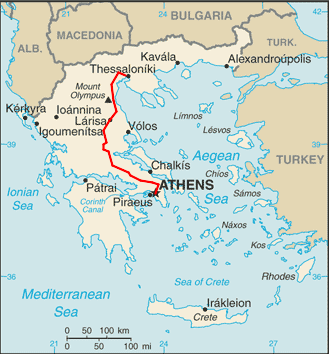

Athens Metro train arrives at the Monastiraki station.
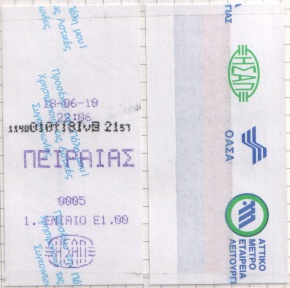
Athens Metro tickets, front and back.
Larissa has effectively been a pair of stations because Greece has had rail lines built to a variety of gauges. For the most part, you can simplify this as standard European gauge in northern mainland Greece, with narrow gauge south from Athens and throughout the Peloponnese, the peninsula that is very nearly an island.

Old and new OSE logos.

The history of the Greek railway system, ΟΣΕ or the Hellenic Railways Organization and its predecessors, explains its current sorry state.
Plans were presented to the Greek government in 1835 to build a railway line from Athens to its port of Piraeus, just 8.8 kilometers of track. A contract was signed and work started in 1857, some 22 years later. Then it took twelve more years, until 1869, for those 8.8 km of track to be built. That's not quite 260 meters per year. I think that I could lay track by hand on my own at that pace.
Starting in 1881, a series of Prime Ministers each signed multiple contracts with various companies to construct sections of railroad. The sets of contracts were, of course, designed to enrich the Prime Ministers, and each of the frequent changes of government meant a cancellation of the existing contracts and creations of new ones better favoring the new officials and further reducing intercompatability.
Greece is still plagued by the mix of different rail gauges resulting from this mess. Cars and locomotives can only travel on sections of track built to the gauge of their wheel sets. Athens' Larissa station connects to the network of European standard gauge lines of 1,435 mm connecting much (but not all) of northern Greece, generally leading north toward Thessaloniki and Europe. Just across the way, maybe 200 meters' walk, is the old Peloponnese station and the 1,000 mm narrow gauge lines running south and west.
Then there are the industrial railways, built in a variety of incompatible gauges: 1,000 mm, 900 mm, 600 mm, and 550 mm.
A project is underway to replace the busy narrow gauge line running south and west from Athens through Korinthos to Patrai. That will move the standard-to-narrow gauge interface from Athens to Korinthos and Patrai. This is yet another project that they hope to finish in time for the 2004 Olympic Games. Yes, I realize that the games happened 21 years ago, I'm just quoting the official party line here.
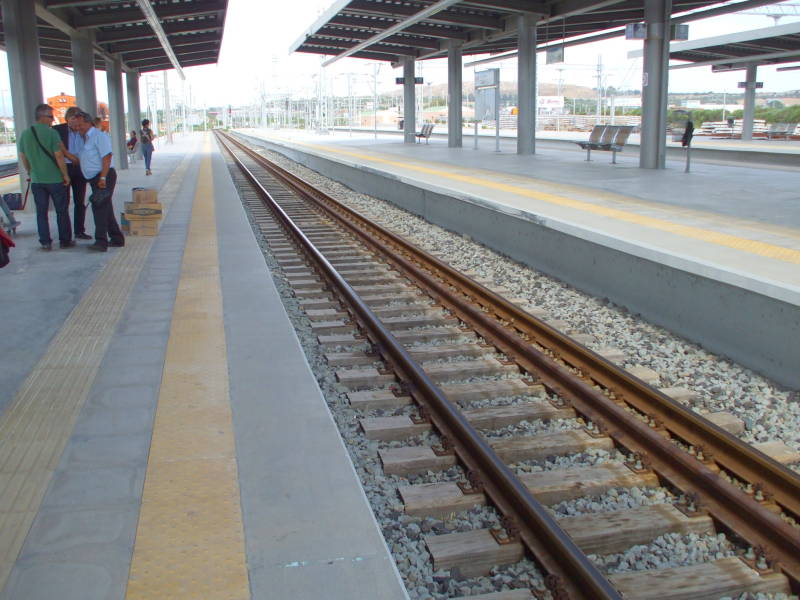
Dual gauge rail line at Korinthos, notice the three rails.
I found during this trip that at least some of the lines from Athens to the Isthmia station, on the Athens side of Korinthos, had been converted to dual-gauge. They have three rails so they can carry either standard or narrow gauge trains. However, the Isthmia station was not yet fully functional.
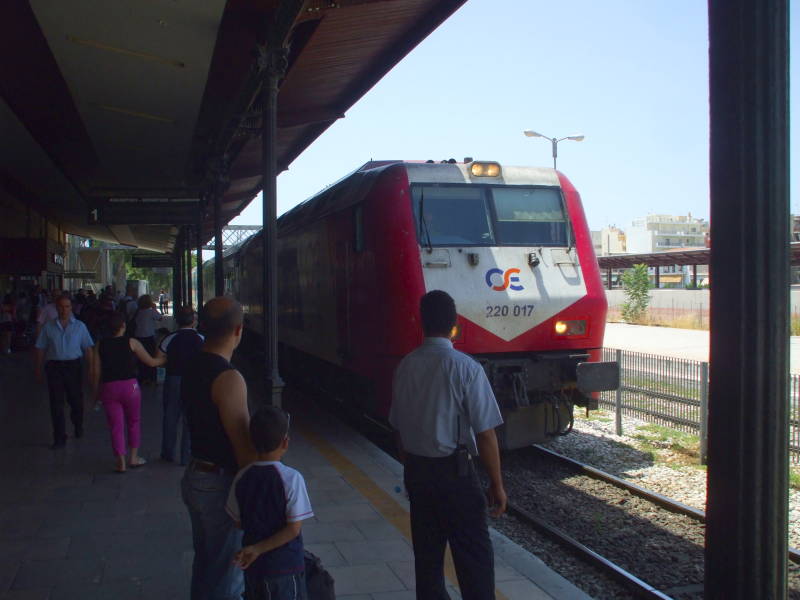
IC 54, the Aristotelis, pulls in to Larissa station in Athens.
Back to planning our Athens-Thessaloniki trip. You will need a ticket, which you can buy at the station. Just give yourself adequate time to make the purchase. However, you can only buy tickets as far as Thessaloniki. You must buy your onward ticket once you get to that station. I tried buying the tickets for the Thessaloniki-Sofia leg of the trip as soon as I got into the country, but I was unable.
There was an office at the Larissa station with a signboard announcing its supposed purpose in both Greek and English: INTERNATIONAL TICKETS
Operating hours were posted on the window. The office was staffed by two men and it was well within the operating hours, but the window was closed. After I had tapped on the glass and stood there long enough that they finally lost hope that I would give up, go away and leave them alone, one of them slid the window open.
I asked them about buying international Greek train tickets. Remember that I was at the main train station in the national capital, asking at the office labeled INTERNATIONAL TICKETS.
They scoffed at me, telling me that of course I had to wait until I got to Thessaloniki to buy those tickets. I stepped back to look up at the sign above the window again, returned to the counter, and asked what could be done at this office. Maybe they could give me details on schedules of the international trains? They slammed the window shut and returned to their cigarettes. I managed to find a schedule of international train connections on my own.
We waited until our return to Athens to buy our tickets to Thessaloniki. Actually, we waited until just before our departure. We took the Metro to the station leaving ourselves plenty of time, bought our tickets, and waited for our train. The tickets were €36.30 each.
The Inter-City train IC 54, the Αριστοτελης or Aristotelis, soon pulled in. The locomotive was mostly in its original red and white color scheme, but the cars were largely covered with graffiti looking like dazzle camouflage or maybe pop art. The passenger coaches for this train are the common basic ones with a narrow corridor down one side along compartments of three seats facing three seats with luggage storage on racks overhead and also above the corridor.
The placard lists the stops of the IC 54 Aristotelis. It is readable only because the placard is a separate panel that can be swapped out after its inevitable defacement by the spray painting Greeks. The Aristotelis starts in Piraeus, Athens' port, seen in the banner at the top of this page. Someone could come in from the islands on a ferry, find their way through the enormous ferry port area to the train station, and immediately start their land journey.
| Trains from Athens to Thessaloniki | ||||
| Train | Depart | Arrive | Stops | Duration |
| E 500 | 09:21 |
15:02 |
10 | 5:41 |
| IC 52 | 10:51 |
15:48 |
9 | 4:57 |
| IC 54 | 13:21 |
18:31 |
12 | 5:10 |
| 502 | 14:53 |
20:51 |
13 | 5:58 |
| ICE 56 | 19:28 |
23:55 |
3 | 4:27 |
| IC 74 | 20:39 |
01:48 |
8 | 5:09 |
| 504 | 22:55 |
05:36 |
7 | 6:41 |
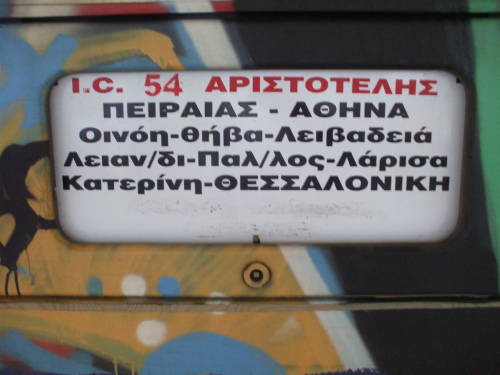
The Greek economy is based largely on graffiti and strikes.
It is enormously helpful to be comfortable enough with the Greek alphabet that you can spot city names while dealing with abbreviations. Notice that the placard on the train shows Παλ/λος when the station name is really Παλαιοφαρσάλος. The station stops along our route on the I.C. 54 will be:
Πειραιάς — Αθίνα — Οινόη — Θήβα — Λειβαδειά — Λειανοκλαδι — Δομοκός — Παλαιοφαρσάλος — Λάρισα — Πλατύ — Θεσσαλονίκι
Or: Peiraias — Athena — Oinoi — Thiva — Leivadeia — Leianokladi — Domokos — Palaiofarsalos — Larisa — Katerini — Plati — Thessaloniki
Amazon
ASIN: B00I6JODV4
Amazon
ASIN: B07GRM8SQG
The express highway north from Athens can follow the coast fairly easily, but the rail line cannot. The Pass of Thermypolae is quite narrow, just ask the Persians. The first map below shows that a new line is under construction through that pass, or at least very near to it. Much of the rail line from Athens to Lamia is very scenic, running through the mountains. Of course, it isn't very fast at all.
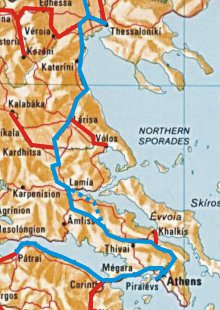
Small section of a map showing Greek railways.
Blue = major line
Red = minor line
Dashed = under construction

Small area of ONC G-3 near Lamia
The more detailed map shows the rail line running northwest from Athens to Lamia (in the upper left corner). In this section the rail line follows a river valley as much as possible, but it has to wind through mountainous terrain from time to time.
One highway follows the same general route, but another highway follows the coast. The Pass of Thermypolae is between Molos and Livanatai.
Here you see a typical OSE diesel-electric locomotive and passenger coaches of the same types as used on the IC 54 Aristotelis. Most of the Greek railway system is not electrified. An exception is the Larissa-Thessaloniki section, which is electrified with 25 kV 50 Hz power. Our train was switched to electric locomotives when we stopped at the Larissa station.
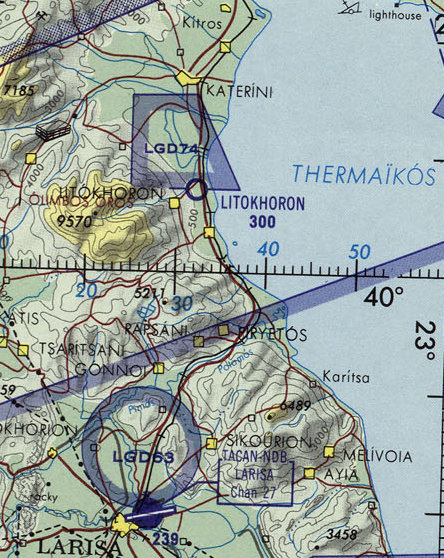
Small area of ONC G-3 near Larissa, showing Mount Olympus near Katerini.

Typical Greek OSE diesel-electric locomotive.
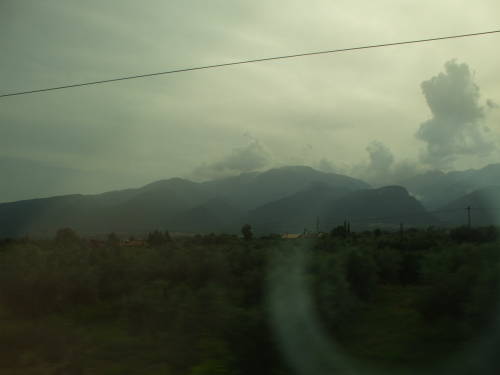
Mount Olympus as seen from the train.
The electrified rail line runs to the coast north of Larissa, and then follows the coast the rest of the way to Thessaloniki.
Before passing Katerini, the line passes near Mount Olympus, the highest peak in Greece.
Self-propelled train like this first one have no separate locomotive. They are used for medium-range trips.
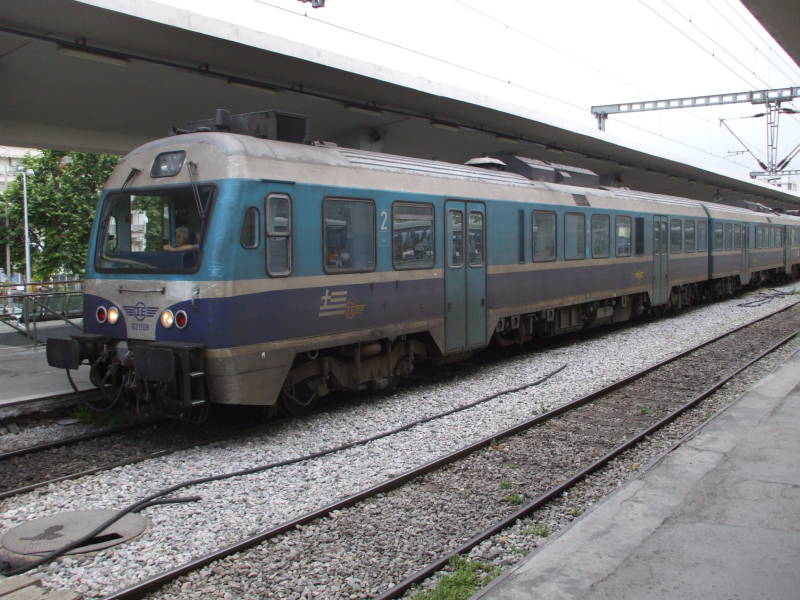
Typical Greek OSE self-powered train used for medium-range trips.
This much more modern Greek train is electrically powered. It has a more open interior plan, and is typically used as a Προαστίακος or Proastiakos suburban train.
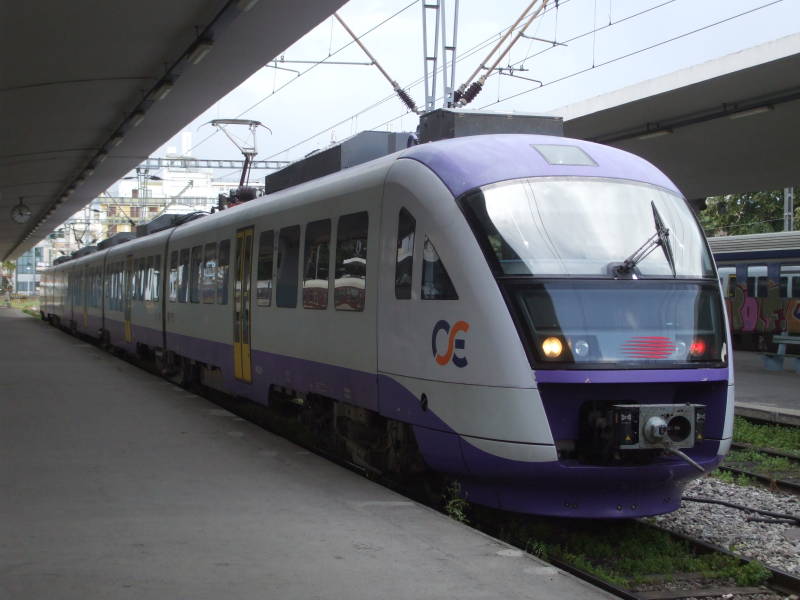
Modern Greek OSE electric-powered train.
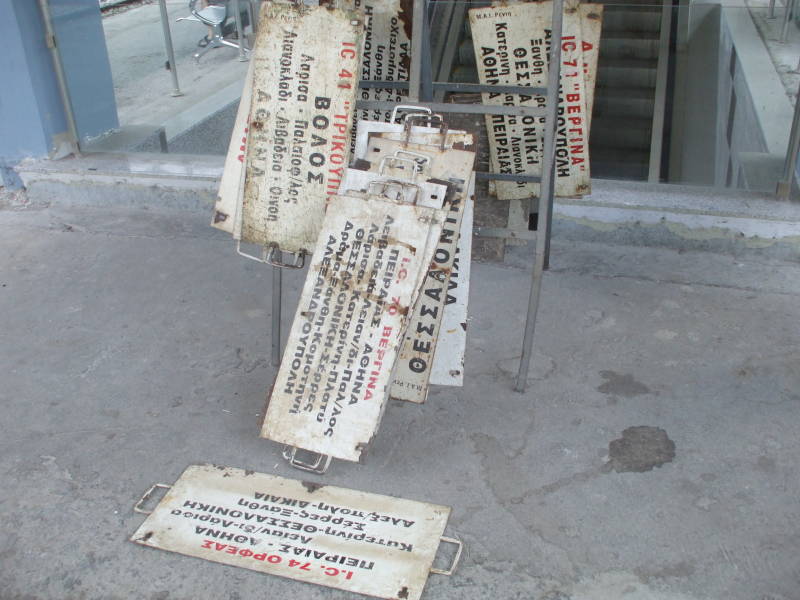
Placards used on Greek passenger trains. These are inserted into slots near the doors of passenger coaches to indicate the train number and name and its station stops.
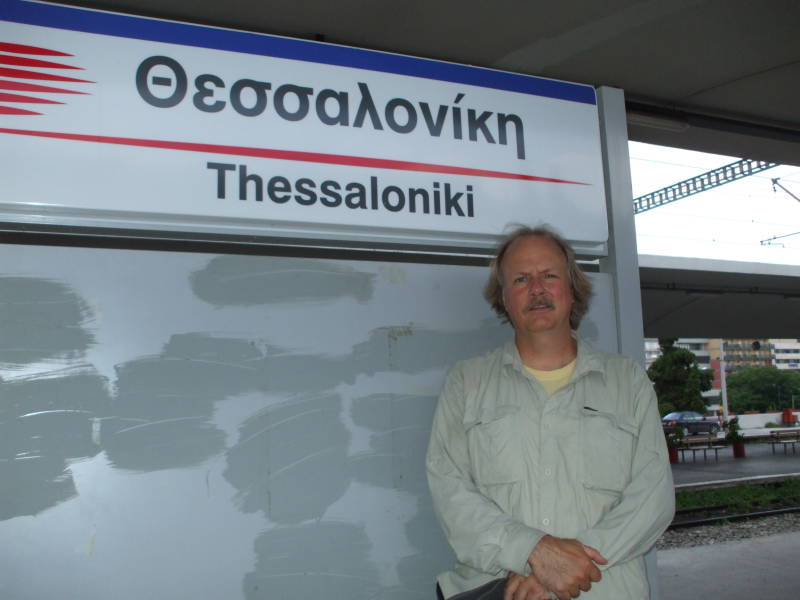
I have made it to Thessaloniki!
I have made it as far as Thessaloniki, most of the way across the first country! Here I am on the platforms used for connections south to the rest of Greece. They can also be used for rail connections north to Macedonia, Bulgaria, and Turkey, at least when Greece has not cut itself off from the European rail network.

Exterior of Hotel Rex.
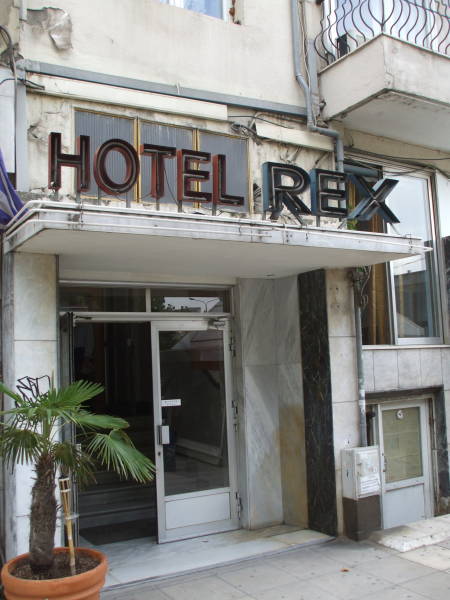
Entrance of Hotel Rex.
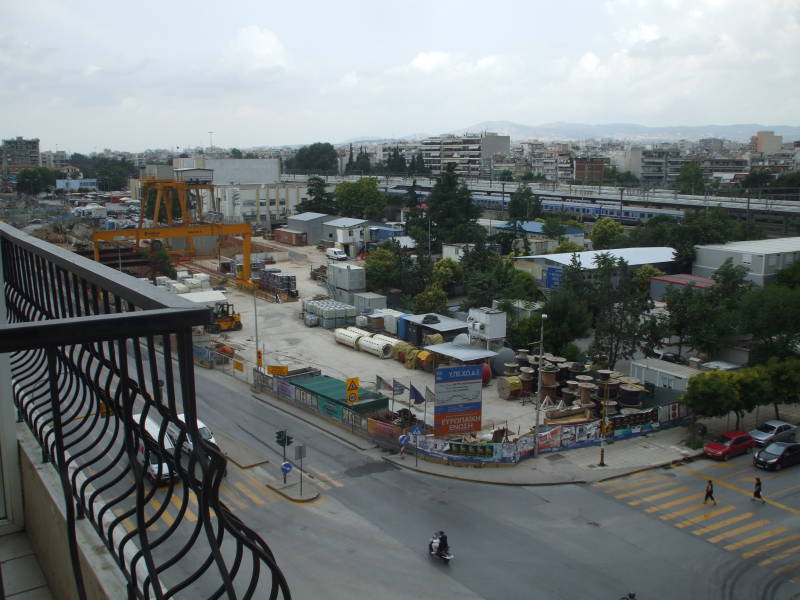
Thessaloniki train station as seen from Hotel Rex. A metro system is being built, the near corner of the station area is filled with equipment and supplies.
We stayed at the Hotel Rex, at 39 Ωδος Μονοστιριου, rexhotelthessaloniki.gr. It's very close to the station: cross the main street, turn left and the hotel is diagonally opposite the end of the station area. It was €50/40 for a double/single room.
Now for the next stage of our trip:
Visit Thessaloniki
or get right onto the
Overnight sleeper train
from Thessaloniki to Sofia, Bulgaria
Back to the International Travel Recommendations